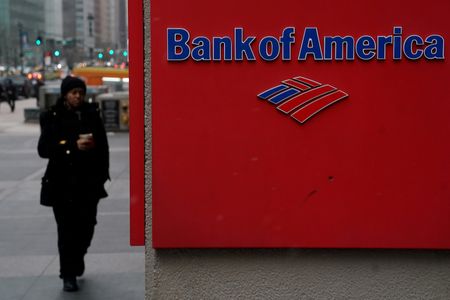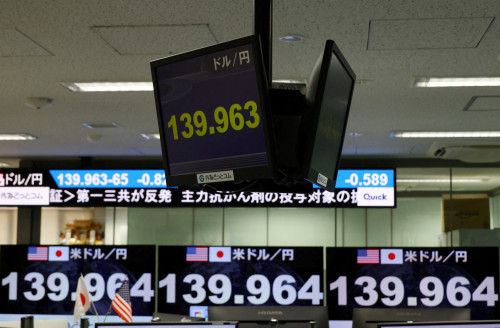By Manya Saini and Saeed Azhar
(Reuters) – Bank of America Corp’s first-quarter profit beat analysts’ estimates as it collected hefty interest payments from customers and its bond traders had their best quarter in a decade.
Rival banking giants JPMorgan Chase & Co and Citigroup Inc also reaped windfalls from higher interest payments in the first quarter, while setting aside billions of dollars to prepare for a worsening economy.
“Everything points to a relatively mild recession, given the amount of stimulus that was paid to people and the money they have left over,” Bank of America CEO Brian Moynihan told analysts on a conference call on Tuesday.
While consumers remain in good financial health, commercial clients have become more cautious about the economic outlook, he said.
The bank is also preparing for a slower economy with headcount projected to fall by about 3,000 to 213,000 by the end of the second quarter from a current 216,000, Chief Financial Officer Alastair Borthwick said.
“We would also expect to see expense reductions coming from headcount reductions through attrition,” he said.
BofA shares were up 0.3% to $30.48 in afternoon trading, trimming earlier gains.
Analysts at Piper Sandler said while the bank had delivered a big beat in earnings, the “market may not reward the shares” so much as earnings were driven by “perhaps unsustainably strong market making activities.”
Bank of America, the second-largest U.S. lender, reported a profit of 94 cents in the three months ended March 31, compared with estimates of 82 cents per share, according to Refinitiv IBES data.
Traders in fixed income, currencies and commodities stayed in high demand, bringing in $3.4 billion in revenue, up 27% from a year earlier.
Credit trading, particularly in mortgages and municipal bonds, also stood out, said Borthwick.
The company “had a strong Q1 as higher interest rates continued to boost its net interest margin despite rising deposit costs,” David Fanger, senior vice president at Moody’s Investors Service, said.
“This, together with strong sales and trading revenues and the seventh consecutive quarter of positive operating leverage, more than offset the adverse impact of modest deposit outflows.”
The collapse of two U.S. lenders in March shook the industry and exacerbated concerns about a looming recession. The crisis battered bank stocks and prompted spooked depositors to move their cash to larger institutions.
Total deposits at BofA fell 1% to $1.91 trillion in the first quarter, compared with the fourth quarter, as customers who were unsatisfied with the deposit rates offered by lenders moved their cash into money market funds to chase greater yields.
Banking crisis turns focus on deposits at big banks https://www.reuters.com/graphics/USA-BANKS/klvygmrxmvg/chart.png
Economists expect the U.S. economy to slow in the second half of the year as the Federal Reserve raises interest rates to tame inflation.
BofA set aside $931 million to cover losses from souring loans, compared with $30 million a year earlier.
Still, “consumers are in great shape in terms of credit quality by any historical standard,” Borthwick said, despite more people falling behind on their payments and concerns about a looming recession, he said.
Combined spending on debit and credit cards was resilient, rising 6% in the quarter, because of strong U.S. employment and wage growth, he added.
Revenue at BofA’s consumer unit rose 21% to $10.7 billion in the first quarter.
The bank’s net interest income (NII), which reflects how much money it makes from charging interest to customers, rose 25% to $14.4 billion in the quarter. It expects NII to fall 2% in the second quarter compared with the first three months of this year.
Fed hikes fan interest income growth at big banks https://www.reuters.com/graphics/USA-BANKS/zgpobjxmqvd/chart.png
Meanwhile, global M&A activity shrank to its lowest level in more than a decade in the first quarter of 2023, hurt by rising interest rates, high inflation and recession fears. The slump in dealmaking has weighed on Wall Street investment banks in recent months, prompting thousands of job cuts.
Bank of America’s investment banking fees fell 20% to $1.2 billion in the quarter.
The company’s revenue, net of interest expense, increased 13% to $26.3 billion, beating estimates of $25.13 billion.
(Reporting by Manya Saini and Niket Nishant in Bengaluru and Saeed Azhar in New York; Additional reporting by Siddarth S; Editing by Lananh Nguyen, Shounak Dasgupta and Nick Zieminski)









